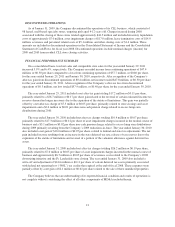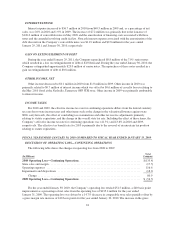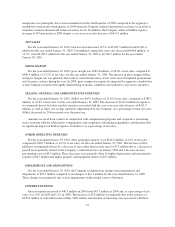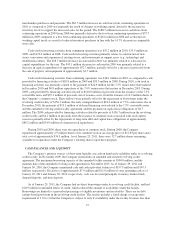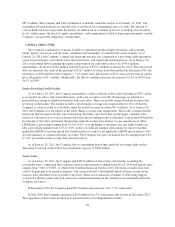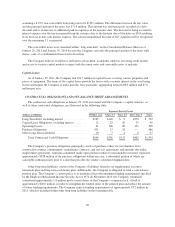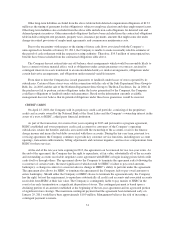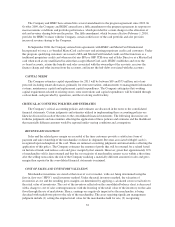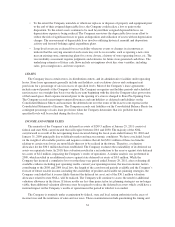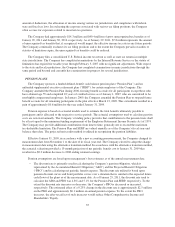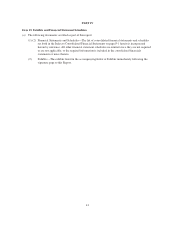Saks Fifth Avenue 2010 Annual Report Download - page 32
Download and view the complete annual report
Please find page 32 of the 2010 Saks Fifth Avenue annual report below. You can navigate through the pages in the report by either clicking on the pages listed below, or by using the keyword search tool below to find specific information within the annual report.Other long-term liabilities excluded from the above table include deferred compensation obligations of $13.2
million as the timing of payments for this obligation is subject to employee elections and other employment factors.
Other long-term liabilities also excluded from the above table include non-cash obligations for deferred rent and
deferred property incentives. Other unrecorded obligations that have been excluded from the contractual obligations
table include contingent rent payments, property taxes, insurance payments, amounts that might come due under
change-in-control provisions of employment agreements, and common area maintenance costs.
Due to the uncertainty with respect to the timing of future cash flows associated with the Company’s
unrecognized tax benefits at January 29, 2011, the Company is unable to make reasonably reliable estimates of
the period of cash settlement with the respective taxing authority. Therefore, $14.3 million of unrecognized tax
benefits have been excluded from the contractual obligations table above.
The Company has not entered into any off-balance sheet arrangements which would be reasonably likely to
have a current or future material effect, such as obligations under certain guarantees or contracts, retained or
contingent interests in assets transferred to an unconsolidated entity or similar arrangements, obligations under
certain derivative arrangements, and obligations under material variable interests.
From time to time the Company has issued guarantees to landlords under leases of stores operated by its
subsidiaries. Certain of these stores were sold in connection with the sale of the Saks Department Store Group to
Belk, Inc. in 2005 and the sale of the Northern Department Store Group to The Bon-Ton Stores, Inc. in 2006. If
the purchasers fail to perform certain obligations under the leases guaranteed by the Company, the Company
could have obligations to landlords under such guarantees. Based on the information currently available,
management does not believe that its potential obligations under these lease guarantees would be material.
CREDIT CARDS
On April 15, 2003, the Company sold its proprietary credit card portfolio, consisting of the proprietary
credit card accounts owned by the National Bank of the Great Lakes and the Company’s ownership interest in the
assets of a trust, to HSBC, a third party financial institution.
As part of the transaction, for a term of ten years expiring in 2013 and pursuant to a program agreement,
HSBC established and owns proprietary credit card accounts for customers of the Company’s operating
subsidiaries, retains the benefits and risks associated with the ownership of the accounts, receives the finance
charge income and incurs the bad debts associated with those accounts. During the ten-year term, pursuant to a
servicing agreement, the Company continues to provide key customer service functions, including new account
openings, transaction authorizations, billing adjustments and customer inquiries, and receives compensation from
HSBC for these services.
At the end of the ten-year term expiring in 2013, the agreement can be renewed for two two-year terms. At
the end of the agreement, the Company has the right to repurchase, at fair value, substantially all of the accounts
and outstanding accounts receivable, negotiate a new agreement with HSBC or begin issuing private label credit
cards itself or through others. The agreement allows the Company to terminate the agreement early following the
occurrence of certain events, the most significant of which would be HSBC’s failure to pay owed amounts,
bankruptcy, a change in control or a material adverse change in HSBC’s ability to perform under the agreement.
The agreement also allows for HSBC to terminate the agreement if the Company fails to pay owed amounts or
enters bankruptcy. Should either the Company or HSBC choose to terminate the agreement early, the Company
has the right, but not the requirement, to repurchase substantially all credit card accounts and associated accounts
receivable from HSBC at their fair value. The Company is contingently liable to pay monies to HSBC in the
event of an early termination or a significant disposition of stores. The contingent payment is based upon a
declining portion of an amount established at the beginning of the ten-year agreement and on a prorated portion
of significant store closings. The maximum contingent payment had the agreement been terminated early on
January 29, 2011 would have been approximately $10.9 million. Management believes the risk of incurring a
contingent payment is remote.
31


